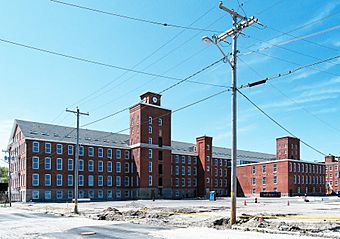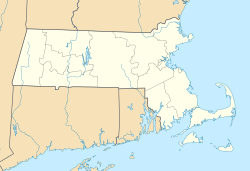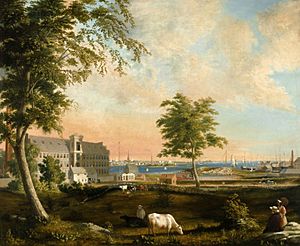Wamsutta Mills facts for kids
Quick facts for kids |
|
|
Wamsutta Mills
|
|
 |
|
| Location | Acushnet Ave., Logan, Wamsutta and N. Front St., New Bedford, Massachusetts |
|---|---|
| Area | 19.3 acres (7.8 ha) |
| Built | 1847 |
| Architect | Thomas Bennett Jr, Edward Kilburn |
| Architectural style | Utilitarian industrial |
| NRHP reference No. | 08000794 |
| Added to NRHP | August 19, 2008 |
Wamsutta Mills was once a big company that made fabrics. Today, it's a well-known brand for things like sheets, towels, and bedding.
The company started in 1846 in New Bedford, Massachusetts. It was built by Thomas Bennett Jr. near the Acushnet River. The name "Wamsutta" came from a Native American chief's son. He was famous for making an agreement with the English settlers of the Plymouth Colony.
Wamsutta Mills was the first fabric factory in New Bedford. Over time, making cotton fabrics became more important than whaling (hunting whales) in the town. This happened by the 1870s.
Wamsutta Mills became famous for making very good quality cotton products. These included shirts and sheets. The Wamsutta brand is still used today. It was sold by Bed Bath & Beyond in North America. In South America, it was sold by Springs Global. After Bed Bath & Beyond closed in 2023, another company, Indo Count Global, bought the brand. They plan to sell Wamsutta products online directly to customers starting in 2025.
Contents
History of Wamsutta Mills
How the Mills Started
Thomas Bennett Jr. from Fairhaven, Massachusetts, first thought of building the Wamsutta Mills. He originally wanted to build it in Georgia. But a powerful investor, Joseph Grinnell, insisted it be in his hometown, New Bedford.
In 1846, the company officially received its charter. By 1847, Bennett had raised $160,000. Most of this money came from small investments. Many New Bedford business people were unsure about the fabric industry. In 1847, the first meeting of the owners took place. Joseph Grinnell was chosen as president. Thomas Bennett Jr. became the secretary and superintendent.
Building the First Mills
Construction of the first mill began in 1847. It was a stone building, about 212 feet long and 70 feet wide. It had five stories. David Whitman from Rhode Island helped with the building and setting up the machinery.
The mill started making cloth in February 1849. Homes were also built for the workers. The business quickly grew. By 1853, the company's money increased to $300,000. A second mill, with four stories, was built in 1855. It was 240 feet long and 70 feet wide.
A third mill, just like the second, was built between 1860 and 1861. It opened in 1865. The delay was because of the Civil War. By 1868, the company's value jumped to $2,000,000. A fourth, even bigger mill was then built. Mill No. 4 was made of brick. It was 495 feet long, 70 feet wide, and had four stories.
Growing Bigger and Better
Thomas Bennett Jr. retired in 1874. Edward Kilburn took his place as superintendent. The company kept growing. By 1875, the company's value reached $2,500,000. Wamsutta fabrics were now being shipped all the way to Australia.
Mill 5 was added north of Mill No. 4. It was also made of brick. This mill was 433 feet long and 93 feet wide. Soon after, Wamsutta started making percale fabric. New Bedford became known as the first city in the United States to make such fine cotton.
A famous textile leader, William Madison Wood, started his career at Wamsutta Mills. He worked there from 1873 to 1876, starting at age fifteen. In 1880, Wamsutta Mills updated its machinery. They replaced old spindles with 20,000 new ones. In 1882, they began building Mill No. 6. It was a brick building, three stories high, and 569 feet long by 95 feet wide.
Success and Modernization
By 1883, Wamsutta Mills had six mills. They produced 26 million yards of cotton cloth every year. Joseph Grinnell remained president until he passed away in 1885. Other leaders then took his place. By 1892, Wamsutta owned seven mills. It was the largest cotton weaving factory in the world. In 1897, Wamsutta had 4,450 looms and employed 2,100 workers.
In 1917, plans were made to update this huge mill. The machinery was improved and replaced. Steam power was changed to electric power. The company started focusing on fine sheets and pillowcases. They also began advertising to the public. At this time, the company had 229,000 spindles and 4,310 looms. New Bedford had many other large spinning and weaving mills too.
Before the Great Depression in the 1920s, New Bedford faced tough times. Many factories in northern textile towns closed. Wamsutta, however, managed to increase its sales in 1925. By 1935, their famous sheets were called Supercale instead of percale. They also made a new product called Lustercale. It was a mix of cotton and a strong type of rayon. This blend felt like cotton but was softer. Later, Lustercale was made with 100% cotton.
Wamsutta also created the perfect fabric for sails on ships. During wars, they made fabrics for hot air balloons, gas masks, and military uniforms. Many other types of fabrics were created for different uses. Even today, Wamsutta is a well-known name for fabrics in homes.
Wamsutta Today
Today, Wamsutta is a brand name owned by different companies. In North America, the brand was owned by Bed Bath & Beyond. They bought the brand in 2012. In South America, the brand is owned by Springs Global, a Brazilian company. As of 2025, Indo Count Global owns the Wamsutta brand for North America.
In 2004, the old Wamsutta Mills buildings in Massachusetts were planned for a new use. The renovation included creating loft-style apartments. These apartments have up to three bedrooms.
See also





